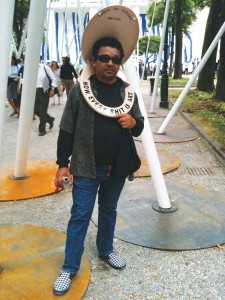« Features
Push to Flush: The Blandness of Biennials
Biennials have become very popular. They are like ready-mades, and like ready-mades, carry contradictory connotations. By “popular,” I mean a kind of artistic platform or product that is globally ubiquitous. Through this article I will introduce a critical perspective to the biennial phenomenon based on two paradigms: the economic and conceptual approaches.
Biennials, like art, are inescapably involved in the formation of value, and not necessarily Karl Marx’s concept of surplus value or Mehrwert. The schizophrenia of the art world still rules ambiguous and fake binary oppositions: art vs. market; biennial vs. art fair; art vs. popular culture; spirituality vs. market, etc.
This démodé Manichean dialectic does not comprehend today’s art complexity and contradiction. Post-modernism was Neo-capitalism’s Trojan Horse, and globalization has created a new cultural regime in which politics, social life and culture are one. Precisely that which Gilles Lipovetsky has coined as “world culture”: a global, market-driven culture in which utopias and former avant-garde’s opposition to bourgeois society have totally evaporated.
Biennials now are standardized, inauthentic, mediocre events that offer conventional products to international audiences. They have been behaving de facto like art fairs, and although this may sound new, it goes back to its own conception.
Venice, the world’s oldest biennials, was first held on April 30, 1895, and its trademarks of “international dialogue” and “the city as meeting place” heralded the birth of city marketing, attracting 200,000 visitors to its inaugural event and more than 440,000 in 2011.
For his Documenta, Arnold Bode took the model of The Armory Show of 1913, a commercial event organized by the Association of American Painters and Sculptors.
If art fairs deal overtly with the market, biennials, in turn-especially Documenta and Venice-become a platform for sanctioning art trends and aesthetic attitudes by declaring what is particular, good or relevant art here and now.
HAVANA AND MANIFESTA
Another important non-mainstream biennial is the Havana Biennial, which kicked off in 1984. But even it has been subjected to unstoppable ‘fairization’ from the moment that Cuba lost its free oil supply due to the collapse of the Soviet Union in 1989.
Already in 1991, German art collector Peter Ludwig visited Havana and started to buy Cuban art. Economic reforms were introduced in 1993, including the de-penalization of hard currency (especially U.S. dollars). Artists started to sell and take advantage of the flow of foreign visitors to the Biennial. Many collectors from the United States and Europe will head to Havana again in May in the hope of buying art at cheaper prices.
Manifesta is on its turn an exciting and challenging example of Dr. Jekyll and Mr. Hyde. It was founded in 1993 with the firm conviction to foster the relationship between Eastern and Western Europe. Except for the Ljubljana Manifesta nothing happened within the former Iron Curtain. Why was the 2004 “Moneyfesta”-to quote Sandra Smallenburg’s 2002 Metropolis M article-in San Sebastian and just six years later in Spain again, this time in Murcia? Money can give us a clue: Hosting the event cost Frankfurt 1.3 million euros in 2002, San Sebastian 2 million euros in 2004 and Murcia 3 million euros in 2010-and some claim it cost that town even more, though that was what was reported by the press there.
ANTI-UTOPIANISM AND FLATNESS
I always thought of biennials as utopias, where utopian thinking and the modeling of possible worlds is a conditio sine qua non.
These days the art world likes to cling to the utopian, even if Post-modernism, led by Lyotard and even Rancière, as well as Neo-capitalism, headed by Fukuyama, have turned it into a devaluated, totally unsexy concept.
Most recent biennials and even Documenta’s have left a lot to be desired. Let’s see. ILLUMInations by Bice Curiger was a big blunder. For its part, The Lyon Biennale and Dublin Contemporary were like twins: “A terrible beauty” is born, curated by Victoria Noorthoorn, and “Terrible Beauty-Art, Crisis, Change & The Office of Non-Compliance,” curated by Jota Castro and Christian Viveros-Fauné, respectively; let’s recall here “The Beauty of Distance” at the Sydney Biennale in 2007 curated by David Elliott. A terrible lack of beautiful ideas I would say, especially as this topic had been tackled profoundly already in “Baroque and Neo-baroque. The Hell of The Beautiful” in 2005 at the Domus Artium (DA2) in Salamanca, Spain.
The coming Manifesta is titled “The Deep of the Modern” and is under the direction of curator Cuauhtémoc Medina and Associate Curators Dawn Ades and Katerina Gregos. It sounds forced and boring. La Triennale at Le Palais de Tokyo and other venues led by Artistic Director Okwui Enwezor and Associate Curators Mélanie Bouteloup, Abdellah Karroum, Emilie Renard and Claire Staebler recently announced its theme: “Intense Proximity.” Wow, that is a piece of deep thinking! And, tout court: the last PROSPECT in New Orleans curated by Dan Cameron didn’t even have a theme!
I’m afraid biennials are just branding tools to bring in high-end tourism and promote soft and hard art-selling strategies. The lack of solid artistic discourses is leading to blandness and meaninglessness-a flat global product that offers a renewed whiff of utopia.




































